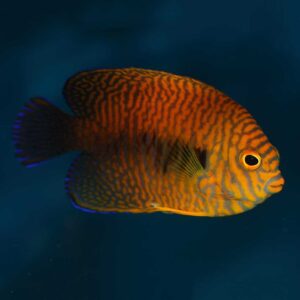The Yellowhead Jawfish (Opistognathus aurifrons) is a visually striking species with a maximum size of around 4 inches (10 centimetres). It has a slender body and a distinct yellow-coloured head, which gives it its common name. The body is typically pale or light brown with darker markings and spots.
Taxonomy
The Yellowhead Jawfish belongs to the family Opistognathidae, which consists of various species of jawfishes. Its closest relatives include other members of the Opistognathus genus. The genus name “Opistognathus” comes from the Greek words “opisthen” meaning “behind” and “gnathos” meaning “jaw,” referring to the position of the lower jaw extending behind the upper jaw. The species name “aurifrons” is derived from the Latin words “aurum” meaning “gold” and “frons” meaning “forehead,” describing the yellow head colouration.
Natural Habitat
In their natural habitat, Yellowhead Jawfish are found in sandy or rubble areas with scattered coral formations. They typically inhabit shallow coastal waters and reef slopes. Their burrowing behaviour allows them to create and occupy burrows in the substrate, which serves as their shelter and breeding ground.
Keeping Yellowhead Jawfish Healthy
Yellowhead Jawfish require moderate care and are considered moderately difficult to keep in aquariums. They thrive in water temperatures ranging from 75-80°F (24-27°C) and prefer a pH range of 8.1-8.4. Maintaining stable water parameters and providing a well-maintained marine aquarium with appropriate filtration is essential for their well-being.
Special Requirements and Feeding
Yellowhead Jawfish require a sandy substrate in the aquarium to allow them to dig and create their burrows. Providing suitable hiding spots, such as coconut shells or blenny homes, helps mimic their natural habitat and makes them feel more secure. They are carnivorous and primarily feed on small meaty foods like brine shrimp, mysis shrimp, and small pieces of fish or shrimp. Offering a varied diet will help ensure their nutritional needs are met.
How Many Should I Keep?
Yellowhead Jawfish are best kept singly or as a mated pair. Keeping more than one male in the same tank can lead to territorial disputes and aggression.
Behaviour
Yellowhead Jawfish are known for their fascinating behaviour around their burrows. They spend a significant amount of time near the entrance of their burrow, observing their surroundings and keeping a watchful eye for potential threats. They will retreat into their burrow when feeling threatened or alarmed. Providing suitable hiding spots in the aquarium, such as coconut shells or blenny homes, can help the Yellowhead Jawfish feel more at home and encourage natural behaviours.
Lighting Preference
Yellowhead Jawfish prefer moderate to high lighting conditions in the aquarium, similar to the lighting found in their natural reef habitats.
Suitable Tank Mates
Yellowhead Jawfish are generally peaceful and can be kept with other non-aggressive species that are compatible with their requirements. Good tank mates include small peaceful fish and invertebrates such as gobies, small wrasses, and small reef-safe shrimp and crabs.
Reproduction in the Wild
Yellowhead Jawfish (Opistognathus aurifrons) reproduce through a process called oviparous reproduction, where fertilization occurs externally. They engage in courtship behaviours and create nests within their burrows for spawning.
Breeding Opistognathus aurifrons
- Set Up:
To breed Yellowhead Jawfish, provide a well-maintained marine aquarium with suitable substrate for burrowing, stable water parameters, and ample hiding spots. The tank should be equipped with appropriate filtration and good water flow.
- Courtship/Spawning:
During courtship, the male Yellowhead Jawfish will display courtship behaviours such as head nodding, jaw gaping, and body shaking to attract the female. Once courtship is successful, the female deposits her eggs on the substrate near the burrow entrance. The male swiftly fertilizes the eggs and collects them in his mouth using his pelvic fins.
- Rearing:
The male incubates the eggs in his mouth for an average period of 8-10 days, during which he does not feed. He guards the eggs, periodically rotating them and ensuring their well-being. After the incubation period, the eggs hatch into larvae within the male’s mouth. The larvae are then released into the water column, where they undergo further development.
Sexual Dimorphism
Yellowhead Jawfish do not exhibit significant sexual dimorphism, making it challenging to visually differentiate between males and females. However, during the breeding season, the male’s mouth is noticeably distended due to the presence of eggs.
Distribution
The Yellowhead Jawfish, Opistognathus aurifrons, is naturally found in the western Atlantic Ocean, specifically in the Caribbean Sea and the Gulf of Mexico. It is not commonly available as a captive-bred or line-bred strain, and most specimens found in the aquarium trade are wild-caught.
Summary
The Yellowhead Jawfish, Opistognathus aurifrons, is a captivating species known for its striking appearance and yellow-coloured head. It reproduces through oviparous reproduction, with the male incubating and protecting the eggs in his mouth. Breeding Yellowhead Jawfish requires a well-maintained marine aquarium with suitable substrate, stable water parameters, and hiding spots. They exhibit minimal sexual dimorphism, and the species is naturally distributed in the western Atlantic Ocean. Although they require moderate care and attention, Yellowhead Jawfish can be a rewarding addition to a suitable marine aquarium, showcasing their unique burrowing behaviour and fascinating reproductive strategies.





Reviews
There are no reviews yet.